Bosna: Police Special Forces
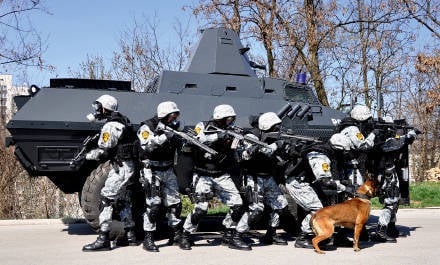 The special police unit of Bosnia and Herzegovina, formed as part of the federal Ministry of the Interior, is historically associated with the special group “Last”, founded in 1982 year in the law enforcement agency of the then socialist republic of Bosnia and Herzegovina, which was part of the former Yugoslavia. Like many similar European police units of the period, a special unit was created in response to the terrorist threats. The unit, formed in December 1982 of the year, was formed from among the most trained and trained Republican police officers who are ready to effectively counter any terrorist threats.
The special police unit of Bosnia and Herzegovina, formed as part of the federal Ministry of the Interior, is historically associated with the special group “Last”, founded in 1982 year in the law enforcement agency of the then socialist republic of Bosnia and Herzegovina, which was part of the former Yugoslavia. Like many similar European police units of the period, a special unit was created in response to the terrorist threats. The unit, formed in December 1982 of the year, was formed from among the most trained and trained Republican police officers who are ready to effectively counter any terrorist threats.The pre-war (meaning the period before the civil war in Yugoslavia at the beginning of the 1990-s. - Ed.) And the later composition of the group were recruited from staff who graduated from high school police or underwent special six-month training courses. Before the war, the group was replenished with active police officers, and during the war, ordinary citizens of Sarajevo.
When the conflict broke out, the unit immediately lost its employees who had Serbian nationality; then the group commander was Milenko Karisik. As a result, an independent division of Bosnia and Herzegovina was created on the basis of the old special group. This happened on 6 on April 1992 of the year. The new formation was given a new name - the Bosna Special Operations Group.
The base for the newly formed unit was the headquarters of the republican police. Initially, the size of the group was 300 – 400 employees, and the first commander was appointed Dragan Wiki, his deputy - Kemal Ademovic. Soon the size of the team grew to 1000 people.
Initially, the Bosn device was a battalion type, in which the group was divided into two combat teams of 100 – 120 people. The rest of the staff was also divided into two divisions. In this case, it was the first two teams that provided the execution of operational tasks. The group acted on direct orders from the President of the Republic or the Minister of the Interior of Bosnia and Herzegovina.
Later, the Bosna group consisted of the command and headquarters, 5 operational teams, the logistics unit, the VIP security unit, the automobile unit and the train support unit.
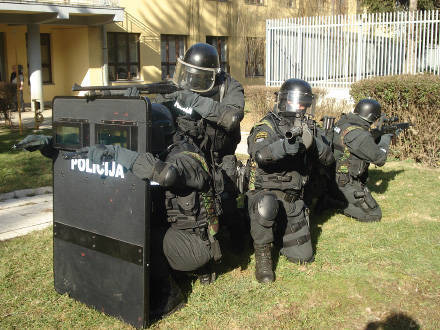 The first and second teams, made up of pre-war specialists and volunteer athletes, were directly subordinate to the group commander and the minister of internal affairs and often acted as a single combat unit. In each of the teams there were 4 platoons consisting of 3 or 4 combat groups, 1 or 2 supporting units, a group of snipers, machine-gun and grenade launchers. In the intervention groups, some of the platoons had a certain specialization and the corresponding weapons and equipment.
The first and second teams, made up of pre-war specialists and volunteer athletes, were directly subordinate to the group commander and the minister of internal affairs and often acted as a single combat unit. In each of the teams there were 4 platoons consisting of 3 or 4 combat groups, 1 or 2 supporting units, a group of snipers, machine-gun and grenade launchers. In the intervention groups, some of the platoons had a certain specialization and the corresponding weapons and equipment.The first and second teams were very often united and could be organized in such a way as to best suit the various options for action. In 1994, an autonomous reconnaissance unit was created in the first intervention team. The remaining teams (3-I, 4-I and 5-I), the so-called positional units, were located on the banks of the river Milyacki, flowing along that part of Sarajevo, which is called Novi Grad, and the suburb of Dobrynya. Their main task was to provide support to the Bosn militant groups. In addition to conventional vehicles, the automobile division had armored vehicles.
The group participated in combat operations in the city of Sarajevo, where intervention teams opposed terrorism. They were also actively involved in the fight against drug traffickers, smugglers, in apprehending criminals suspected of murder, etc.
In total, in the special Bosn group from 5 on April 1992 of the year to November of 1995, when the Dayton agreements were signed that stopped the conflict, 1376 specialists acted, among whom 81 died during the war (among them one woman) and 270 were injured.
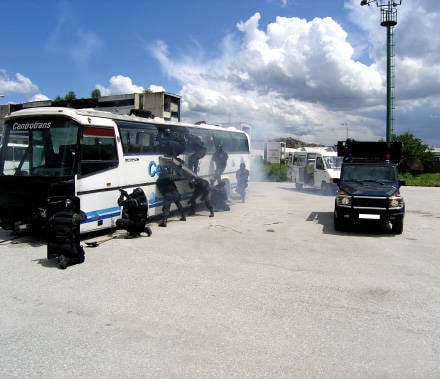 In accordance with the reorganization of the security forces in 2001 and the creation of a new federal police department, a special group has also undergone certain changes. New elements were included in its structure: the team leader had deputies for operational work, security, training and logistics.
In accordance with the reorganization of the security forces in 2001 and the creation of a new federal police department, a special group has also undergone certain changes. New elements were included in its structure: the team leader had deputies for operational work, security, training and logistics.The headquarters also introduced a communications unit and a cryptographic protection team.
Combat units were divided into operational groups A, B, C.
Operational group A included operational teams A1, A2, a team of snipers and an automotive team.
Team B included teams B1 and B2, an operations team and a team of climbers.
Team C includes teams C1 and C2 and a team of divers.
The last reorganization took place on 11 on April 2011, and since then the group structure has remained unchanged.
Organization and tasks
Today, Bosnian police special forces are ready to act in all weather conditions and situations, in different environments, in rural or urban areas, effectively fighting all types of crime. The team is capable of detaining and neutralizing terrorist acts or terrorist groups suspected of committing terrorist acts, blocking armed criminals or suspected of having been killed, accused of robbery, aggravated theft, theft, etc. Also, the group’s specialists are called to release hostages taken in buildings and on all types of transport.
Employees of the special group received special training, having received the appropriate certificates for performing special operations.
They are also attracted to ensure the safety of VIPs. Operational teams can also participate in special police measures to curb riots, including correctional facilities, other public places where their knowledge and skills are required for a safe resolution of the situation.
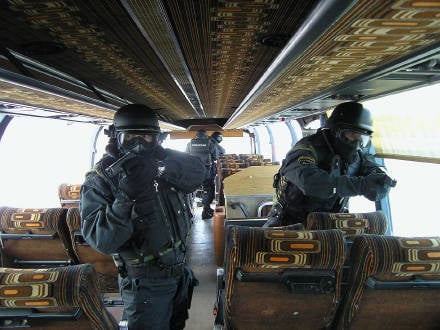 It is also worth noting that the police special forces are actively involved to assist the local population during natural disasters or in the aftermath of their consequences. Team members can search for victims who have drowned in water, save people from avalanches in the mountains, and deliver food to hard-to-reach places in the country under bad weather conditions.
It is also worth noting that the police special forces are actively involved to assist the local population during natural disasters or in the aftermath of their consequences. Team members can search for victims who have drowned in water, save people from avalanches in the mountains, and deliver food to hard-to-reach places in the country under bad weather conditions.A special group of the Federal Police Department is located in Sarajevo in the Otok district today and is under the direct supervision of the Minister of the Interior of Bosnia and Herzegovina.
Today, the internal structure of the group is:
- command;
- instructor team;
- operational teams ALFA, BETA, GAMMA;
- DELTA base security team;
- helicopter unit;
- logistic section.
The headquarters of the group consists of the commander (this is the senior inspector Ibro Besley) and his deputies for operational work, security, law and logistics. The team of instructors brings together specialists mentors in shooting, tactics, sniping, counter-sabotage protection, mountaineering, hand-to-hand combat, swimming, parachute and physical training, scuba diving, driving, the use of working dogs. Operational units include invasion and support teams.
The helicopter unit is intended for the transfer of the group’s personnel to the location of the tasks, air reconnaissance, evacuation, search and rescue operations, etc. In addition, helicopters can be used as a platform for snipers.
In the air park of the group are helicopters from “BELL-206 B” and “BELL-206 L-1 Long Ranger”.
Training
Selection and training of employees of the group carried out by programs similar to similar units in other countries. However, potential civilian candidates are subject to a very tight selection system. Recruitment of the group is carried out on a voluntary basis, while the candidate must work for at least one year in the police force, be of age from 18 to 35 years and have the necessary physical conditions for service.
When they are admitted to a group, candidates pass physical and psychological tests, undergo a physical examination and an interview with the unit commander.
Candidates who receive high scores on the entrance tests are admitted to a six-month basic training course, during which the natural selection of applicants continues. During the period of basic training, candidates acquire initial knowledge in the field of tactics, shooting, hand-to-hand combat, and mountaineering. Also, great attention is paid to the ability to act as a team and adequately endure long-term psychological pressure. During the first six months, candidates significantly increase their physical level and acquire the skills of making the right decisions in an emergency.
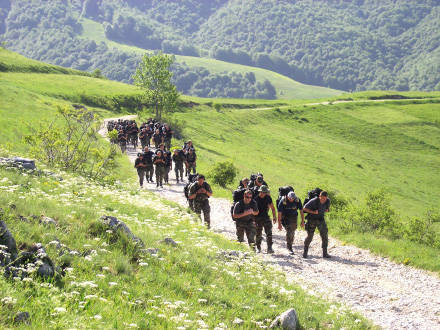 After completing basic training, candidates take courses in using full-time firearms. weapons and accurate shooting. For six months, the applicants are closely watched by instructors who know exactly what kind of fighters are needed in the special forces. Those candidates who have successfully completed the basic course, further deepen their knowledge and skills in special courses to become fighters of one of the “specialized” divisions - mountaineering, “diving”, parachuting, etc.
After completing basic training, candidates take courses in using full-time firearms. weapons and accurate shooting. For six months, the applicants are closely watched by instructors who know exactly what kind of fighters are needed in the special forces. Those candidates who have successfully completed the basic course, further deepen their knowledge and skills in special courses to become fighters of one of the “specialized” divisions - mountaineering, “diving”, parachuting, etc.Training of all employees of operational teams ALFA, BETA, GAMMA is conducted throughout the year in a continuous mode.
Trainings are designed in such a way as to simulate the real combat situations as accurately as possible. Modeling crisis cases that cause increased stress among employees allows them to adapt their psyche and develop the most effective response to such situations.
Instructors are selected, as a rule, from among the most trained and experienced team members. They are primarily responsible for the training of all special forces. Preparation is carried out on 10 main areas, which we have already mentioned above. In this case, combat training is the main academic subject.
SWAT police work closely with specialists from the faculty of sports and body development at the university in Sarajevo, who helped put together tests to test the physical endurance of the group's employees. Tests include checking motor skills, endurance, the so-called explosive strength, flexibility, coordination, agility, etc. Naturally, special forces have special, and rather high, requirements. In addition to summer physical training, classes are also held in winter: employees make ski slopes in the highlands in order to gain the skills of conducting combat and rescue operations in hard-to-reach areas.
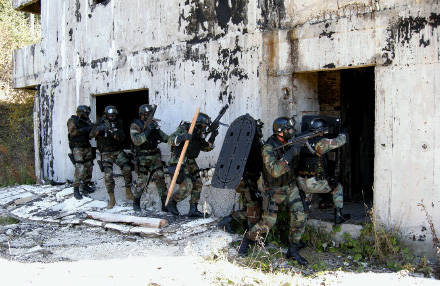 The tactics of the group today meets the current trends inherent in special forces around the world. Therefore, the ALFA, BETA, GAMMA invasion teams are fully prepared, trained and equipped with everything necessary for the effective execution of the assigned tasks.
The tactics of the group today meets the current trends inherent in special forces around the world. Therefore, the ALFA, BETA, GAMMA invasion teams are fully prepared, trained and equipped with everything necessary for the effective execution of the assigned tasks.The group regularly conducts tactical exercises and training sessions, the scenario of which is as close to reality as possible. At these classes, special forces use special “marker” ammunition, which allows employees to fire at each other, thus simulating real fire contact during detention, for example, a group of terrorists or an armed criminal.
During training, much attention is paid to shooting from various types of small arms. The group has a so-called rubber town (rubber town) - a special training complex that imitates urban neighborhoods, in which employees work out various tactics when performing the most difficult police tasks. In the course of training, special ammunition is used here, and the culmination of the educational process is the development of actions using real ammunition of various calibers. Training is carried out daily, including often at night using special ammunition and equipment.
The basic training of the parachute team takes place in the educational center in the city of Banja Luka and consists of a series of psychophysical tests, during which the strength, agility, and endurance of the special forces and their reactions to emergency situations are assessed. It also provides basic training in shooting, tactics and mountaineering.
The cynological team consists of specialists and instructors. Canine and service dogs have their specific specialization: the fight against terrorism, the detection of drugs, explosives, the search and rescue. All dogs in this division are a breed of Belgian Shepherd (Malinois). Cynologists are part of the invasion team and must participate in the conduct of combat operations.
In the diving team, all specialists have their own certified category: M1 diving instructors, independent R3, R2 divers, and advanced divers.
Climbing team is intensively training for rescue operations in the mountains. Also, its specialists possess the skills of the so-called vertical invasion in high-rise buildings and urban buildings. In addition, police climbers actively interact with the canine unit when they are searching in the mountains for avalanches or people injured or injured. The team is also used to evacuate skiers stuck on mountain lifts.
The selection and training of candidates for the sniper unit is the most difficult task for the management team. Contenders for this elite specialty are subject to increased requirements. Usually, future snipers are chosen from the personnel of the task forces. As a rule, they are those employees who show the best results in shooting and possess a set of psycho-physiological qualities necessary for this combat profession.
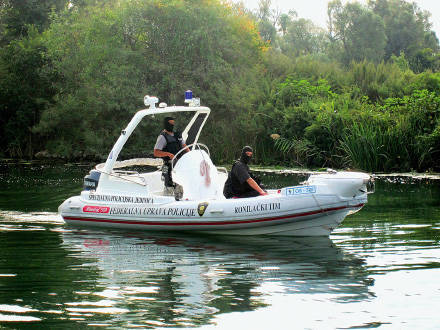 Sniper training is mainly carried out in accordance with a special training course. The training method consists of three main stages: direct training in shooting, training in positioning and masking, training in tactical methods of combat use of snipers in the group.
Sniper training is mainly carried out in accordance with a special training course. The training method consists of three main stages: direct training in shooting, training in positioning and masking, training in tactical methods of combat use of snipers in the group.Cooperation
A special group of police of Bosnia and Herzegovina is actively developing international cooperation. She has established close contacts with a number of similar special police units, as well as sports and educational organizations around the world. Bosnian Special Forces cooperate with the French RAID group, the Italian GIS group, the German SEK group, the American Marshall Service and the FBI, the Austrian Cobra group, the Greek SAJ, special anti-terrorist police units of Turkey, Montenegro, Croatia, the Serbian SAJ group, the Slovenian diving association, diving - Croatian Police Center, Shtukenbrock Service Dog Training Center, German Special Forces Training Center, etc.
Weapons and equipment
The team members use three types of uniforms: black tactical overalls for night operations, “digital” camouflage for urban gray-blue action and a multi-overalls for action in rural areas. On the right sleeve is the chevron of the federal police department, and on the left sleeve is the emblem of the federal police of Bosnia and Herzegovina. The distinctive sign of the group is beret gray.
Snipers use special camouflage suits that vary depending on the time of year. To hide the face during operations, employees wear black or gray masks. Complete the outfit with special boots and tactical gloves.
For personal protection, investigators can use modular body armor of level IIIA protection with ceramic plates, as well as American and Greek-made tactical vests. The heads of the special forces protect ballistic helmets of the IIIA protection level with a visor, they can also wear conventional Pro-Tec Ace Walter helmets without ballistic protection. For eye protection, ESS (eye protection system) and tactical glasses are used. To protect themselves from explosive devices, employees can equip themselves in a special protective suit Holdfast Systems PTY Ltd EOD Equipment. It is usually used by instructors of service dogs when searching for and neutralizing explosive devices.
When conducting operations, the Bosnian Special Forces use special equipment, high-level armored vehicles, as well as a heavy ballistic shield on the wheels. Among the ammunition and special equipment are AVON protective masks, Safariland and Blackhawk belts and holsters, knee pads and elbow pads, bags for transporting weapons and equipment, as well as tents and sleeping bags.
The group uses very modern equipment, mainly of western production, acquired in the last few years.
Of the so-called “collective” equipment, the group has ladders of various types and sizes, special sets for invading a room not only through doors, including armored ones, but even through a wall.
Personal short-barreled weapons in the group are Glock 17, Smith & Wesson, Tanfoglio Stock II pistols (all 9 mm). All are equipped with Streamlight TLR-2 and Glock GTL 22 tactical laser illuminators.
The group's main weapons are German H&K MP-5 and MP-5 SD3 submachine guns (with an integrated silencer) of 9 mm caliber.
In the arsenal there are self-loading rifles FNH SCAR, SG 551 SWAT, SG 552 – 2 Commando and SG 553. They can be equipped with silencers, Aimpoint, Trijicon and EO-Tech optical designators, as well as 40 mm caliber grenade launchers. In addition, the special forces can act, armed with self-loading rifles Zastava M70 AB2 and M16 A1.
Snipers mainly use Alpine TPG-1 manual-action rifles with Schmidt & Bender scopes, Steyr Tactical Elite with Leupold scopes and H&K SG with ZFM scopes. The group's arsenal also includes a 76 mm Zastava Arms M7,9 semi-automatic sniper rifle with a ZRAK telescopic sight. As additional tools, snipers use ATN Bushnell and ATN Range Eve 1500 rangefinders, as well as a ballistic computer.
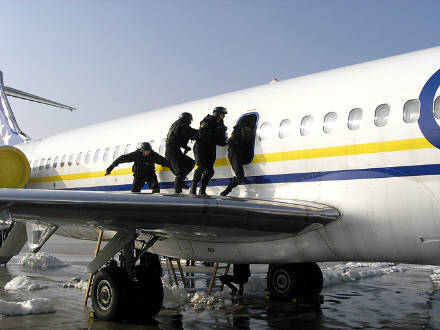 Other types of weapons include Mossberg, Remington, Baikal IL-81, FN Minimi machine gun, Corner Shot special gun for shooting from the corner with a display, Taser X26 non-lethal weapons, Piexon type JPX Jep Protector with integrated laser sight, as well as a special stun gun for animals DIST-INJECT.
Other types of weapons include Mossberg, Remington, Baikal IL-81, FN Minimi machine gun, Corner Shot special gun for shooting from the corner with a display, Taser X26 non-lethal weapons, Piexon type JPX Jep Protector with integrated laser sight, as well as a special stun gun for animals DIST-INJECT.For night-time actions, the group includes an ATN monocular, Pathfinder 2000 night vision devices, an ATN X2000 XP infrared camera, and a number of others.
For communication, the Bosnian special forces use Motorola GP 344 radio stations.
WV Golf V, WV Passat cars, Toyota Land Cruiser, Land Rover Defender and Mercedes SUVs, as well as special armored transporters TAM BOV-1 are in the garage of the group.
The parachute team is equipped with the main parachute Stilleto 150 and a spare parachute PD-160 R, a protective helmet, a digital altimeter Skytronics GFX and an analog Aeronaut Classic MT.
The diving team has various types of boats and the most modern diving equipment, allowing to solve a wide range of tasks.
Information